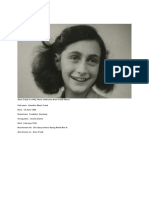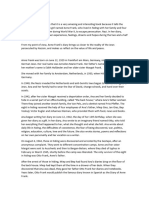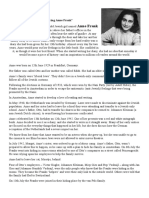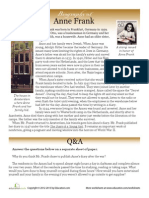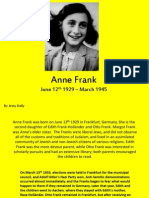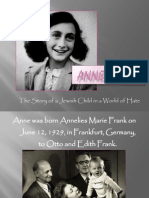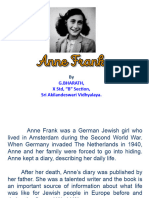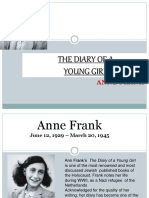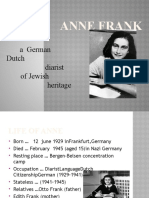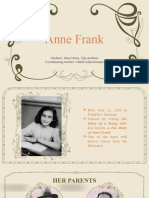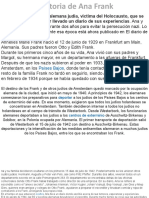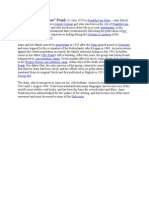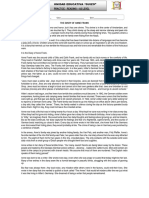0 ratings0% found this document useful (0 votes)
11 viewsAnne Frank
Anne Frank
Uploaded by
penelope.sautronAnne Frank was a young Jewish girl who went into hiding with her family during the Nazi occupation of the Netherlands. She wrote about her experiences in hiding in a diary. Anne and her sister were eventually discovered and deported to concentration camps, where they both died of illness.
Copyright:
© All Rights Reserved
Available Formats
Download as PPTX, PDF, TXT or read online from Scribd
Anne Frank
Anne Frank
Uploaded by
penelope.sautron0 ratings0% found this document useful (0 votes)
11 views21 pagesAnne Frank was a young Jewish girl who went into hiding with her family during the Nazi occupation of the Netherlands. She wrote about her experiences in hiding in a diary. Anne and her sister were eventually discovered and deported to concentration camps, where they both died of illness.
Original Description:
BIOGRAPHIE ANNE FRANC
Original Title
Anne frank
Copyright
© © All Rights Reserved
Available Formats
PPTX, PDF, TXT or read online from Scribd
Share this document
Did you find this document useful?
Is this content inappropriate?
Anne Frank was a young Jewish girl who went into hiding with her family during the Nazi occupation of the Netherlands. She wrote about her experiences in hiding in a diary. Anne and her sister were eventually discovered and deported to concentration camps, where they both died of illness.
Copyright:
© All Rights Reserved
Available Formats
Download as PPTX, PDF, TXT or read online from Scribd
Download as pptx, pdf, or txt
0 ratings0% found this document useful (0 votes)
11 views21 pagesAnne Frank
Anne Frank
Uploaded by
penelope.sautronAnne Frank was a young Jewish girl who went into hiding with her family during the Nazi occupation of the Netherlands. She wrote about her experiences in hiding in a diary. Anne and her sister were eventually discovered and deported to concentration camps, where they both died of illness.
Copyright:
© All Rights Reserved
Available Formats
Download as PPTX, PDF, TXT or read online from Scribd
Download as pptx, pdf, or txt
You are on page 1of 21
Anne frank
Who is Anne Frank ?
Anne Frank
Annelies Marie Frank, better known as Anne
Frank, was born on June 12, 1929 in the
German city of Frankfurt am Main, lived with
her sister Margot, 3 years older than her, and
her parents Otto and Edith Frank.But at that
time Germany was in crisis: there was little
work and a lot of poverty. Adolf Hitler and his
Nazi Party have more and more followers.
Hitler harbored a fierce hatred towards the
Jews and held them responsible for all the
problems facing the country. He skillfully plays
with the anti-Semitic feelings that reigned in
Germany at the time. Hatred towards Jews and
the unfavorable economic climate pushed Otto
and Edith Frank to move to Amsterdam.
Who protected her ?
Miep Gies
Hermine “Miep” Gies-Santrouschitz, born February 15, 1909 in
Vienna and died January 11, 2010 in Hoorn in the Netherlands at the
age of 100, was a Dutch Catholic who initially rescued Jews, then hid
Anne Frank and her family from the Nazis during World War
What happened before this ?
The descent into hell…
On September 1, 1939, when Anne was 10
years old, Nazi Germany attacked Poland.
Shortly after, on May 10, 1940, the Nazis
also invaded the Netherlands. The Dutch
army surrendered five days later . Slowly
but effectively, the invaders began to make
life more and more difficult for the Jews.
They no longer had access to public parks,
cinemas or businesses. His father lost his
business because of a law prohibiting Jews
from have their own business. All Jewish
children, including Anne, must therefore
attend a school reserved exclusively for
them.
Who denounced them ?
Anorld Van den Bergh
It would be a certain « Anorld Van den
Bergh » a Jewish notary who denonced the
hiding place of the Franks to save his own
family.
But before Anne Frank was discovered where
did she live ?
The Annex
Nazi repression went further and further, forcing
Jews to wear the yellow star. Rumors that Jews
must leave the country begin to spread. When,
on July 5, 1942, Margot received a summons to
come and work in Germany, her parents
suspected that it was a pretext and decided that
the time had come to hide. The next day they
went into hiding, hoping to escape persecution.
In the spring of 1942, with the help of several of
his former colleagues, Otto Frank set up a secret
apartment in the annex of his company located at
263, Prinsengracht. Shortly after, four other
illegal immigrants will join the Frank family in
the Annex. There is little space in the apartment,
Anne has to keep a low profile and is often
afraid.
A future celebrity
The diary
Anne receives a diary on the occasion of her thirteenth birthday, her last birthday in
freedom. In her diary she will describe the period spent in the Annex but she will also talk
about her feelings and thoughts. Anne will also write some short stories, start a novel and
note extracts from her favorite readings in her Book of Beautiful Phrases. Writing helps her
get through the days. One day, Anne hears on Radio Orange (the underground radio station
in the Netherlands) a speech by the Minister of Education of the Dutch government calling
for the preservation of diaries and other documents. recounting the suffering of the people
during the war. Anne then decides to rework her various diaries with the aim of turning
them into a novel titled Het Achterhuis (The Annex).
The refuge is discovered
Anne begins to rewrite her diary but she will not be able to complete her
mission. On August 4, 1944, the refuge was discovered. Anne and the
other illegal immigrants are arrested by the police, as are two of their
protectors. Until today the reason for this police raid remains unknown.
Anne's manuscripts were preserved despite the police operation: two other
protectors managed to save the papers before the Annex was emptied
under Nazi order .
Anne is deported to Auschwitz
The camp
Through the Sicherheitsdienst, the
Amsterdam detention center and the
Westerbork transit camp, the Nazis
deported the group to the Auschwitz-
Birkenau extermination camp. The train
journey takes three days and Anne is
crammed into a cattle car with nearly a
thousand other people. There was little
water and food available during the
journey and a simple small barrel served as
a toilet. Upon arrival at Auschwitz, Nazi
doctors selected the prisoners they deemed
capable of carrying out the hard forced
labor. Around 350 members of Anne's
transport were directly murdered. Anne,
her sister and their mother are interned in a
women's camp. Otto is imprisoned in a
men's camp.
Anne perishes in Bergen-Belsen
The illness wins
At the beginning of November 1944 Anne and her
sister were transported to the Bergen-Belsen camp.
Their parents remained in Auschwitz. In the
Bergen-Belsen camp the conditions are dramatic:
there is almost no food, it is cold and just like her
sister, Anne is suffering from typhus. In February
1945, Margot then Anne died from this illness.
Otto, Anne's father, was the only survivor of all the
illegal immigrants who had taken refuge in the
Annex. He returned to the Netherlands after the
liberation of the Auschwitz camp by Soviet troops.
He learns of the death of his wife Edith during his
long journey home. Once he returns to the
Netherlands he will also learn that Anne and
Margot are no longer alive.
Anne's diary becomes world famous
Anne frank
Otto is greatly impressed by his daughter's
manuscripts. He reads there that Anne dreams of being
a novelist or journalist and of her plan to have her
writings on life published in the Annex. Convinced by
friends, Otto decides to publish the newspaper. On
June 25, 1947, The Diary of Anne Frank was
published with a print run of 3,000 copies. The story
does not end there: the book will be translated into
nearly 70 languages, and followed by a play and a
film. People around the world are learning about
Anne’s story. In 1960, the Annex became: the Anne
Frank House. Until his death in 1980, Otto remained
very involved in the Anne Frank Foundation and the
museum: he hoped that through the Journal, readers
would become aware of the dangers of discrimination,
racism and anti-Semitism.
You might also like
- Anne Frank Was A Teenage Jewish Girl Who Kept A Diary While Her Family Was in Hiding From The Nazis During World War IIDocument6 pagesAnne Frank Was A Teenage Jewish Girl Who Kept A Diary While Her Family Was in Hiding From The Nazis During World War IILuz María RamírezNo ratings yet
- Work Visa Declaration Form May 2018Document2 pagesWork Visa Declaration Form May 2018Arnold AvilaNo ratings yet
- Anne Frank BiographyDocument4 pagesAnne Frank BiographyGeorgeNo ratings yet
- Focus Project FinalDocument3 pagesFocus Project FinalLuiza OttNo ratings yet
- Greatest Woman in HistoryDocument2 pagesGreatest Woman in HistoryJanice Loh (Lovely Janice)No ratings yet
- Anne FrankDocument3 pagesAnne FrankIcy IzzyNo ratings yet
- Anne Frank's Childhood: Adolf HitlerDocument24 pagesAnne Frank's Childhood: Adolf HitlerAira Joy Perez GonzalesNo ratings yet
- Shely Mae EyongDocument3 pagesShely Mae EyongRierie Victor AndoNo ratings yet
- Anne Frank Diary Author Biography, Historical Background and InfluenceDocument6 pagesAnne Frank Diary Author Biography, Historical Background and Influencedeekshith18jNo ratings yet
- Ana FrankDocument2 pagesAna Frankcarbonetti.micaelaNo ratings yet
- Confined 2 Reading Comprehension Exercises Writing Creative W 134117Document9 pagesConfined 2 Reading Comprehension Exercises Writing Creative W 134117Matt DrewNo ratings yet
- Anne Frank: By: Hannah Mulan Li 李木兰Document8 pagesAnne Frank: By: Hannah Mulan Li 李木兰hannah liNo ratings yet
- Anne Frank Book ReportDocument8 pagesAnne Frank Book Reporthendrix_salcedoNo ratings yet
- Anne Frank: Adolf HitlerDocument3 pagesAnne Frank: Adolf HitlerhopieNo ratings yet
- Biography AFDocument2 pagesBiography AFRoshan PrinceNo ratings yet
- Anne Frank WorksheetDocument1 pageAnne Frank WorksheetIdinaNo ratings yet
- Anne Frank Powerpoint World History 1Document10 pagesAnne Frank Powerpoint World History 1api-253359483No ratings yet
- Biography of Anne FrankDocument1 pageBiography of Anne FrankKOMBAN GAMINGNo ratings yet
- Anne FrankDocument1 pageAnne Frankclil360No ratings yet
- Anne FrankDocument18 pagesAnne Frankapi-239980785No ratings yet
- Anne Frank Intro Prepared by G.bharath X B SectionDocument13 pagesAnne Frank Intro Prepared by G.bharath X B SectionGNANASEHARAN ARUNACHALAMNo ratings yet
- Anne FrankDocument21 pagesAnne FrankBhoomikaNo ratings yet
- Annelies Marie FrankDocument3 pagesAnnelies Marie Frankathu.atharva2009No ratings yet
- Anne Frank: Kresna Born in GermanyDocument4 pagesAnne Frank: Kresna Born in GermanyCintia NandaNo ratings yet
- The Legacy of Anne Frank: About This BookDocument14 pagesThe Legacy of Anne Frank: About This Bookn_nadinaNo ratings yet
- Anne FrankDocument4 pagesAnne FrankKeisyCastroNo ratings yet
- Anne Frank's ChildhoodDocument3 pagesAnne Frank's ChildhoodTravisJonesNo ratings yet
- AnafrDocument32 pagesAnafrgabytomescu9112No ratings yet
- Anne Frank ProjectDocument11 pagesAnne Frank ProjectGinny100% (2)
- Teaching GuideDocument18 pagesTeaching GuideSilvia CicconeNo ratings yet
- Nazi Occupation: Best Known ForDocument2 pagesNazi Occupation: Best Known ForJoyce AgnerNo ratings yet
- Frankfurt Am Main Concentration Camp Diary The Netherlands Nazi Adolf Hitler Otto Frank AmsterdamDocument5 pagesFrankfurt Am Main Concentration Camp Diary The Netherlands Nazi Adolf Hitler Otto Frank AmsterdamRiya PatilNo ratings yet
- Quotes: Despite Everything, I Believe That People Are Really Good at HeartDocument3 pagesQuotes: Despite Everything, I Believe That People Are Really Good at HeartMayrelle DgNo ratings yet
- Diary of Anne FrankDocument14 pagesDiary of Anne Frankraj buildconjamNo ratings yet
- The Diary of A Young Girl: Anne FrankDocument19 pagesThe Diary of A Young Girl: Anne FrankDivy AgarwalNo ratings yet
- .Trashed 1699231977 t2 e 3096 Anne Frank Differentiated Reading Comprehension Activity - Ver - 4Document4 pages.Trashed 1699231977 t2 e 3096 Anne Frank Differentiated Reading Comprehension Activity - Ver - 4sugacondawww65No ratings yet
- Anna FrankDocument1 pageAnna FrankchiaraNo ratings yet
- Anne FrankDocument8 pagesAnne FrankAkhilesh SinhmarNo ratings yet
- Anne FrankDocument13 pagesAnne FrankMaria IatanNo ratings yet
- The Diary of A Young Girl - Charactersketch of All CharactersDocument6 pagesThe Diary of A Young Girl - Charactersketch of All CharactersÂdítÿa Śûd50% (2)
- Anne FrankDocument13 pagesAnne FrankMaria IatanNo ratings yet
- Anne Frank: Students: Iatan Maria, Niță Andreea Coordonating Teacher: Chirilă Alina RoxanaDocument13 pagesAnne Frank: Students: Iatan Maria, Niță Andreea Coordonating Teacher: Chirilă Alina RoxanaMaria IatanNo ratings yet
- Extraordinary Lives-Anne Frank Reading Comprehension TextDocument4 pagesExtraordinary Lives-Anne Frank Reading Comprehension Textirindany.mendozaNo ratings yet
- Anne Frank: Cerbj 10th Grade Social Studies Miss RuthDocument4 pagesAnne Frank: Cerbj 10th Grade Social Studies Miss RuthKevin RojasNo ratings yet
- Abt Anni FrankDocument1 pageAbt Anni FrankkayalbaraniNo ratings yet
- Ana FrankDocument4 pagesAna FrankUwUNo ratings yet
- Grace - Anne Frank The Diary of Young GirlDocument10 pagesGrace - Anne Frank The Diary of Young GirlGrace Marselina Datu TasikNo ratings yet
- Anne Frank PageDocument1 pageAnne Frank Pageapi-266672861No ratings yet
- Internals - Anne FrankDocument6 pagesInternals - Anne Frankgudisijyothi43No ratings yet
- Anne Frank's StoryDocument32 pagesAnne Frank's StoryAndy SherwinNo ratings yet
- Otto Frank Edith Frank Holländer Margot: About Annelies Marie FrankDocument3 pagesOtto Frank Edith Frank Holländer Margot: About Annelies Marie FrankWali AshrafNo ratings yet
- Annelies Marie FrankDocument2 pagesAnnelies Marie FrankAkansha NagNo ratings yet
- Annelies MarieDocument1 pageAnnelies MarieRakkeshfulwariaNo ratings yet
- Anne Frank House Amsterdam: Anne's Secret Annex turned into MuseumFrom EverandAnne Frank House Amsterdam: Anne's Secret Annex turned into MuseumRating: 5 out of 5 stars5/5 (1)
- A History For Today: This Is Annelies "Anne" FrankDocument1 pageA History For Today: This Is Annelies "Anne" FrankMike McDonaldNo ratings yet
- The Girl Who Was The Victim of The HolocaustDocument17 pagesThe Girl Who Was The Victim of The Holocaustnikhil_satish_3No ratings yet
- Anne S Frank SummeryDocument2 pagesAnne S Frank Summerypali.basadaNo ratings yet
- Annelies MarieDocument1 pageAnnelies Mariedana_dana11No ratings yet
- The Diary of Anne Frank - ReadingDocument2 pagesThe Diary of Anne Frank - ReadingAnita Paulina Alulema SantamaríaNo ratings yet
- Legal Advice Competition Notes and Digests On Modes of Acquiring CitizenshipDocument8 pagesLegal Advice Competition Notes and Digests On Modes of Acquiring CitizenshipNiña Marie DescallarNo ratings yet
- NHD Final BibliographyDocument11 pagesNHD Final BibliographyMichelle XiongNo ratings yet
- CA7Document2 pagesCA7NickNo ratings yet
- C.A. No 473 PDFDocument4 pagesC.A. No 473 PDFChristian VillarNo ratings yet
- Redacted NTADocument2 pagesRedacted NTAMax Rivlin-NadlerNo ratings yet
- Bi Letter Request and Cert CDocument5 pagesBi Letter Request and Cert Cgrace st johnNo ratings yet
- Express Entry Rounds of Invitations: 1. Fill Out The Online FormDocument6 pagesExpress Entry Rounds of Invitations: 1. Fill Out The Online FormLinkaizerNo ratings yet
- T5 B61 Condor FDR - 6-3-03 Memo Re Briefing - Non Immigration Visa Process - 5 Pgs 221Document5 pagesT5 B61 Condor FDR - 6-3-03 Memo Re Briefing - Non Immigration Visa Process - 5 Pgs 2219/11 Document ArchiveNo ratings yet
- 2013 S PDFDocument2 pages2013 S PDFDiego González SanchoNo ratings yet
- Please Detach and Retain This Instruction Sheet For Your RecordsDocument6 pagesPlease Detach and Retain This Instruction Sheet For Your RecordsoahambaNo ratings yet
- Osmilda Bonilla-Martinez, A077 670 908 (BIA May 15, 2017)Document8 pagesOsmilda Bonilla-Martinez, A077 670 908 (BIA May 15, 2017)Immigrant & Refugee Appellate Center, LLC100% (1)
- Singapore Format v39Document1 pageSingapore Format v39Ujjwal BakshiNo ratings yet
- PDS NewDocument14 pagesPDS NewCHARLOTTE GALLEGONo ratings yet
- Nova Scotia Experience: Express Entry Application GuideDocument26 pagesNova Scotia Experience: Express Entry Application GuideHassan FarazNo ratings yet
- APUSH CH 12 13 Test Practice QuestionsDocument4 pagesAPUSH CH 12 13 Test Practice QuestionsAnonymous jpE6dVMdNo ratings yet
- GLOSOM 2018 Web SmallDocument170 pagesGLOSOM 2018 Web SmallsofiabloemNo ratings yet
- Letter of AcceptanceDocument2 pagesLetter of Acceptancegurjinderkaurgill259No ratings yet
- Directive 22Document3 pagesDirective 22shermanNo ratings yet
- Application Form: Years 8 To 12 Entry To Selective High Schools inDocument4 pagesApplication Form: Years 8 To 12 Entry To Selective High Schools inharryNo ratings yet
- FC 029 PDFDocument2 pagesFC 029 PDFRichardNo ratings yet
- ItineraryDocument5 pagesItineraryKajiNo ratings yet
- Audi A4Document10 pagesAudi A4cin3009No ratings yet
- Francisco Fabian-Medrano, A205 150 585 (BIA Nov. 24, 2014)Document8 pagesFrancisco Fabian-Medrano, A205 150 585 (BIA Nov. 24, 2014)Immigrant & Refugee Appellate Center, LLCNo ratings yet
- ELPHK - Chapters 11-17Document324 pagesELPHK - Chapters 11-17hklabourbookNo ratings yet
- Z1A1197441Document2 pagesZ1A1197441FIKRI RAHMANNo ratings yet
- Checklist BusinessDocument1 pageChecklist BusinessAmeya MungaleNo ratings yet
- A3C Sourcebook 2016-2018Document60 pagesA3C Sourcebook 2016-2018Stanford A3CNo ratings yet
- Details About Malaysian Visa Online - CLICK2VISASDocument7 pagesDetails About Malaysian Visa Online - CLICK2VISASghent2008No ratings yet
- Sample Scam Letter - Beware - US - Department - of - State - United - States - Permanent - Resident - Card - For - XXXXXXXDocument2 pagesSample Scam Letter - Beware - US - Department - of - State - United - States - Permanent - Resident - Card - For - XXXXXXXRav GroverNo ratings yet


